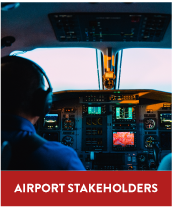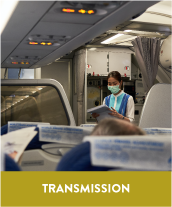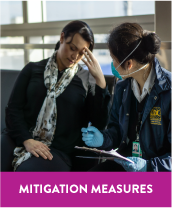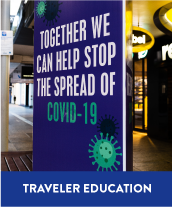Airport Management: Guide

Airport Staff
Staff at airports in the United States, including individuals or organizational departments responsible for overseeing communicable disease responses but not limited to airport operations staff; tenants and concessionaires; janitorial staff; security personnel including local law enforcement and fire marshals; transportation operators including buses and trains; and airline staff, including baggage handlers and ticketing agents.
Department Leads
Airport Community Calls
Implement daily or weekly morning calls between the airport leadership team and the airport’s tenants and employees to share information about the operations, the health threat, and how the organization is addressing it. This will ensure everyone knows what their roles and responsibilities are.
Executives
Team Meeting
Implement daily morning calls or virtual meetings between airport executives and primary airport stakeholders focused on the latest information about the pandemic, the implementation of changes, and the impact on operations.
Consistently distribute information gathered from the airport executive meetings to each department through manager forums, situational reports, digital bulletin boards, authority-wide email blasts, virtual meetings, and/or daily calls. This information should include the prioritization for the week, transparent roles and responsibilities for each department, and clear and concise verbiage on policies and guidelines.
Law Enforcement/ Security
Transportation Security Administration
The Transportation Security Administration’s (TSA) Transportation Security Officers (TSOs) are considered essential personnel and can interact with hundreds, even thousands of passengers daily. TSA worked with different airports to implement barrier shield installations and the creation of physical separation mechanisms (i.e., placing of metal search tables between passenger and Explosive Trace Detection tables).1 The U.S. Department of Transportation (USDOT) recommends various practices to keep TSOs protected, including ensuring that all TSOs are wearing appropriate PPE such as masks and gloves; ensuring there is increased separation from passengers and enforcement of social distancing requirements; implementing screening procedures that limit physical contact with the passengers; and frequent routine cleaning of high-touch surfaces.2
Multiple airports implemented new screening procedures to avoid contact between TSOs and passengers. For example, some large airports implemented technology that minimizes physical contact during passenger travel document checks while providing enhanced fraudulent identity document detection capabilities, confirming the identity of travelers along with providing their flight information.3
Customs and Border Protection
To minimize exposure, Customs and Border Protection (CBP) enforced social distancing and personal protective equipment (PPE) requirements for all their officers and passengers during the COVID-19 pandemic. All employees who could not telework were given extensive PPE that included plexiglass shields at screening desks, N95 respirators, eye protection, and disposable outer garments, along with comprehensive guidelines on how to use the PPE properly. This level of PPE was distributed based on infectious disease risk, job function, and job setting. All the CBP facilities were also issued sanitary guidelines to further prevent the spread of communicable diseases and ensure that their workforce was safe and able to accomplish their mission. The USDOT highly encouraged airports to separate passengers within the queuing space to adhere to social distancing practices while limiting the number of passengers allowed into the Federal Inspection Station.
Aviation Organizations
Airport Council International (ACI) accreditation assesses the airport’s health policies to ensure they are in line with the COVID-19 Business Recovery guidelines and the International Civil Aviation Organization (ICAO) Council Aviation Recovery Task Force (CART) standards. The ACI-World Airport Health Accreditation (AHA) Program is a voluntary, industry-specific self-assessment that focuses on airport-specific operations. Those operations include airport cleaning and disinfection, physical distancing, signage, communication, and facilities based on ICAO CART topics.4 To apply, the airport completes a self-assessment, followed by an online ACI validation interview with key personnel. Recommendations are made for improvement or accreditation is awarded for the next 12 months. Ongoing accreditation relies on continuous improvement and evidence-based self-assessment submissions. Currently, over 400 airports are accredited globally for the ACI World AHA accreditation.
Traveling Public
Passengers and the general public use airport facilities every day and all planning should recognize how the customer experience plays into passenger volume. After the onset of COVID-19, fear of infection reduced air travel to lows that had not been seen since immediately following 9/11. Businesses inside of, and dependent upon, airports, such as car rental agencies, restaurants, and hotels, all saw corresponding reductions in revenue. The financial impact of the interruption cascaded throughout many local economies, adversely affecting many businesses with only indirect ties to air travel. In order to rebuild these systems, customer confidence in the safety of air travel must be restored.
While commercial airline activity is improving, there is some speculation that business travel may not rebound as strongly as personal or tourism travel due to how businesses responded to the COVID-19 lockdowns with remote work, conference calling, and other measures. In contrast, general aviation airports have recently reported increasing traffic, which may indicate a shift in the mode of business travel toward increased usage of charter and corporate aircraft.
Restoring the confidence of travelers regarding safety from a health perspective is going to be partly dependent upon how passengers perceive the experience going forward. The airport experience has changed drastically from new health protocols to a reduction in food options and heightened screening. Airports will require guidelines on simultaneously responding to communicable diseases without negatively impacting the customer experience, even when ancillary businesses downsize operations.
[1] Pesoke, David P. (2021). “20 Years After 9/11: The State of the Transportation Security Administration.” Accessed October 1, 2021 from https://www.tsa.gov/news/press/testimony/2021/09/29/20-years-after-911-state-transportation-security-administration
[2] Guidance Jointly Issued by the U.S. Departments of Transportation, Homeland Security, and Health and Human Services. (2020). The United States Framework for Airlines and Airports to Mitigate the Public Health Risks of Coronavirus. Runway to Recovery. https://www.transportation.gov/sites/dot.gov/files/2022-02/Runway_to_Recovery_1.1_DEC2020_Final-508.pdf
[3] Transportation Security Administration. (n.d.). “Credential Authentication Technology.” https://www.tsa.gov/travel/security-screening/credential-authentication-technology
[4] ICAO. (2020). Council Aviation Recovery Task Force Report. Retrieved February 1, 2021, from https://www.icao.int/covid/cart/Documents/CART%20Report%20Final.pdf
Banner image credit: Unsplash



